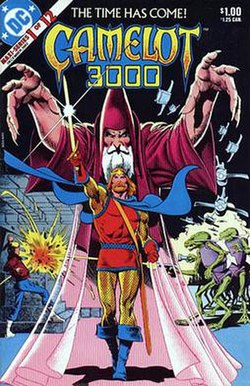Camelot 3000
| Camelot 3000 | |
|---|---|

Camelot 3000 #1 (December 1982). Layout by Ross Andru, pencils and inks by Brian Bolland.
|
|
| Publication information | |
| Publisher | DC Comics |
| Schedule | Monthly |
| Format | Limited series |
| Publication date(s) | December 1982 – April 1985 |
| No. of issues | 12 |
| Creative team | |
| Written by | Mike W. Barr |
| Penciller(s) | Brian Bolland |
| Inker(s) | Bruce Patterson Terry Austin |
| Colorist(s) | Tatjana Wood |
Camelot 3000 is an American twelve-issue comic book limited series written by Mike W. Barr and penciled by Brian Bolland. It was published by DC Comics from 1982 to 1985 as one of its first direct market projects, and as its first maxi-series. It was also the first comic book series to be printed on Baxter paper instead of newsprint.
The series follows the adventures of King Arthur, Merlin and the reincarnated Knights of the Round Table as they reemerge in an overpopulated future world of 3000 A.D. to fight off an alien invasion masterminded by Arthur's old nemesis, Morgan Le Fay.
Barr came up with the concept of Camelot 3000 in approximately 1975, having been inspired by a college course he took in Arthurian literature. He submitted the proposal to DC Comics several years later, only to have it rejected. He then submitted it to Marvel Comics, where it was accepted for serialized publication in one of their black-and-white magazines, but for unknown reasons the project did not get off the ground at this point. The Camelot 3000 concept was resubmitted to DC the following year, and this time was accepted. DC decided to run it as a maxi-series. Barr enlisted Dr. Sally Slocum, the teacher of the course which first inspired Camelot 3000, as a creative consultant for the series.
Camelot 3000 was British artist Bolland's first major work in the USA. At the time the logistics of transatlantic collaborations were difficult, and the series was created using the full script method in part because it was the easiest way for Barr and Bolland to work together while an ocean separated them. This was also the first time that Bolland's work was inked regularly by someone other than himself. Bolland was not comfortable with this and made his pencils very heavily detailed in order to leave the inker as little room for creative reinterpretation as possible. This, combined with Bolland's personal goal to top himself with each new issue, made it difficult for him to keep up with the series's monthly schedule, and the last several issues were late. Barr recounted that Bolland spent nine months drawing the final issue.
...
Wikipedia
